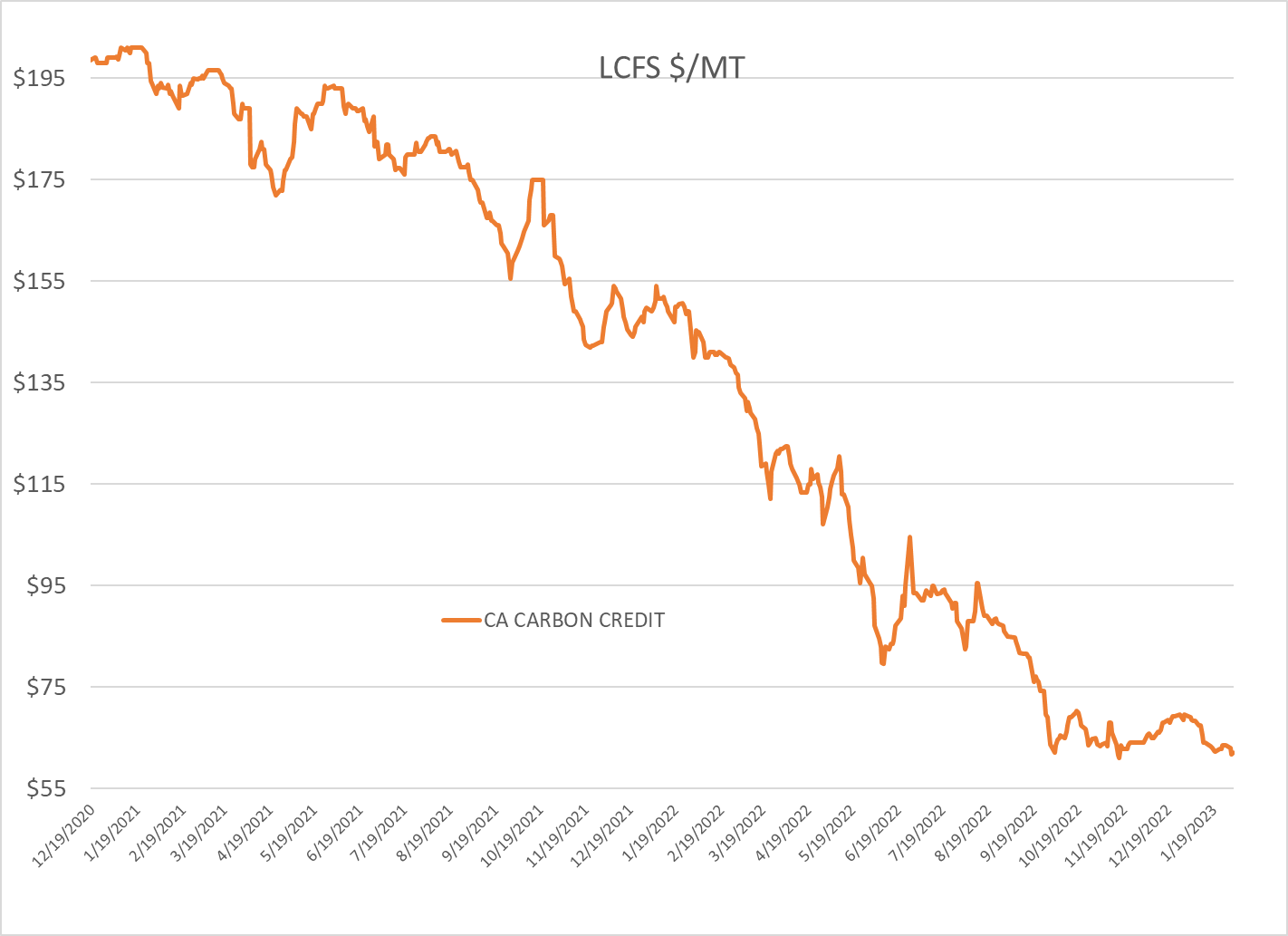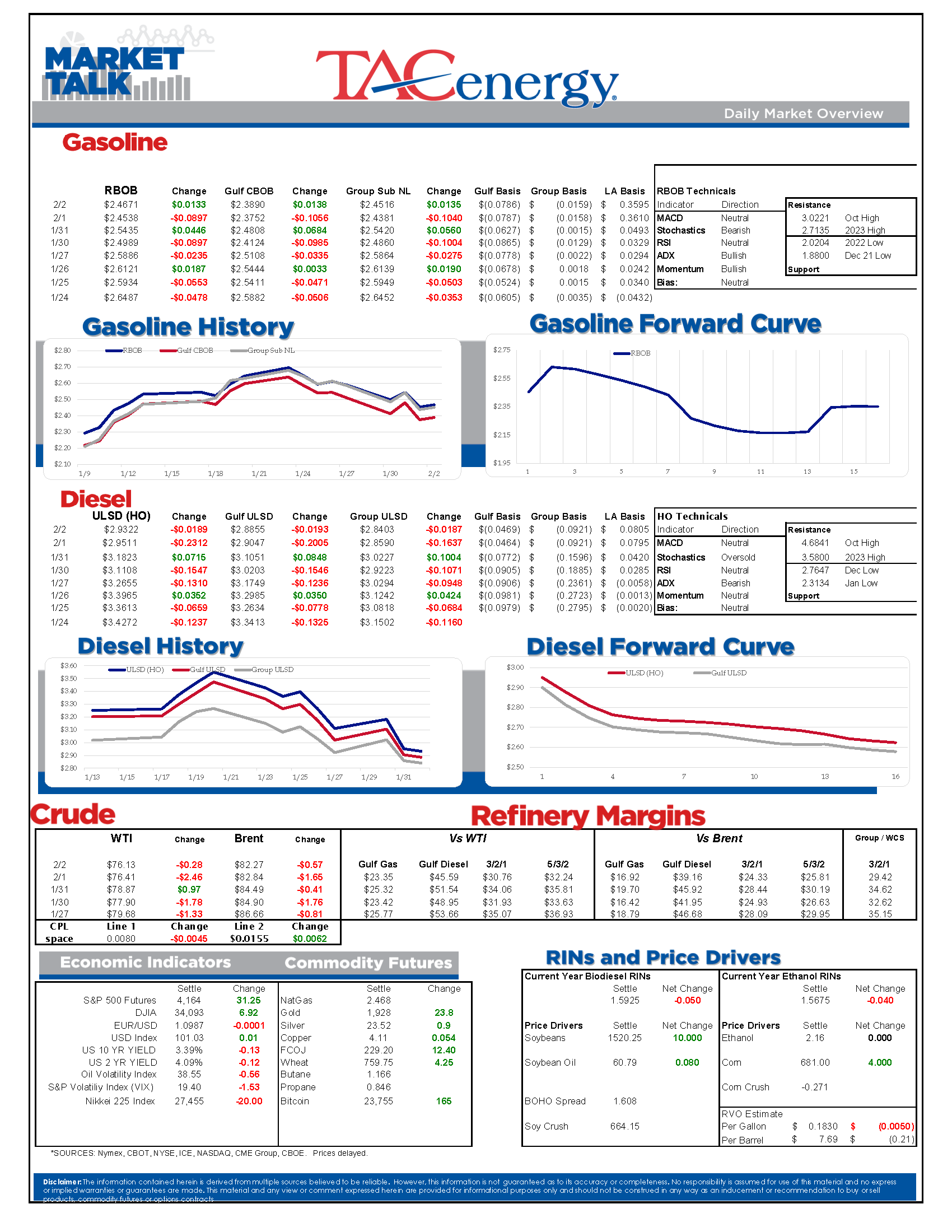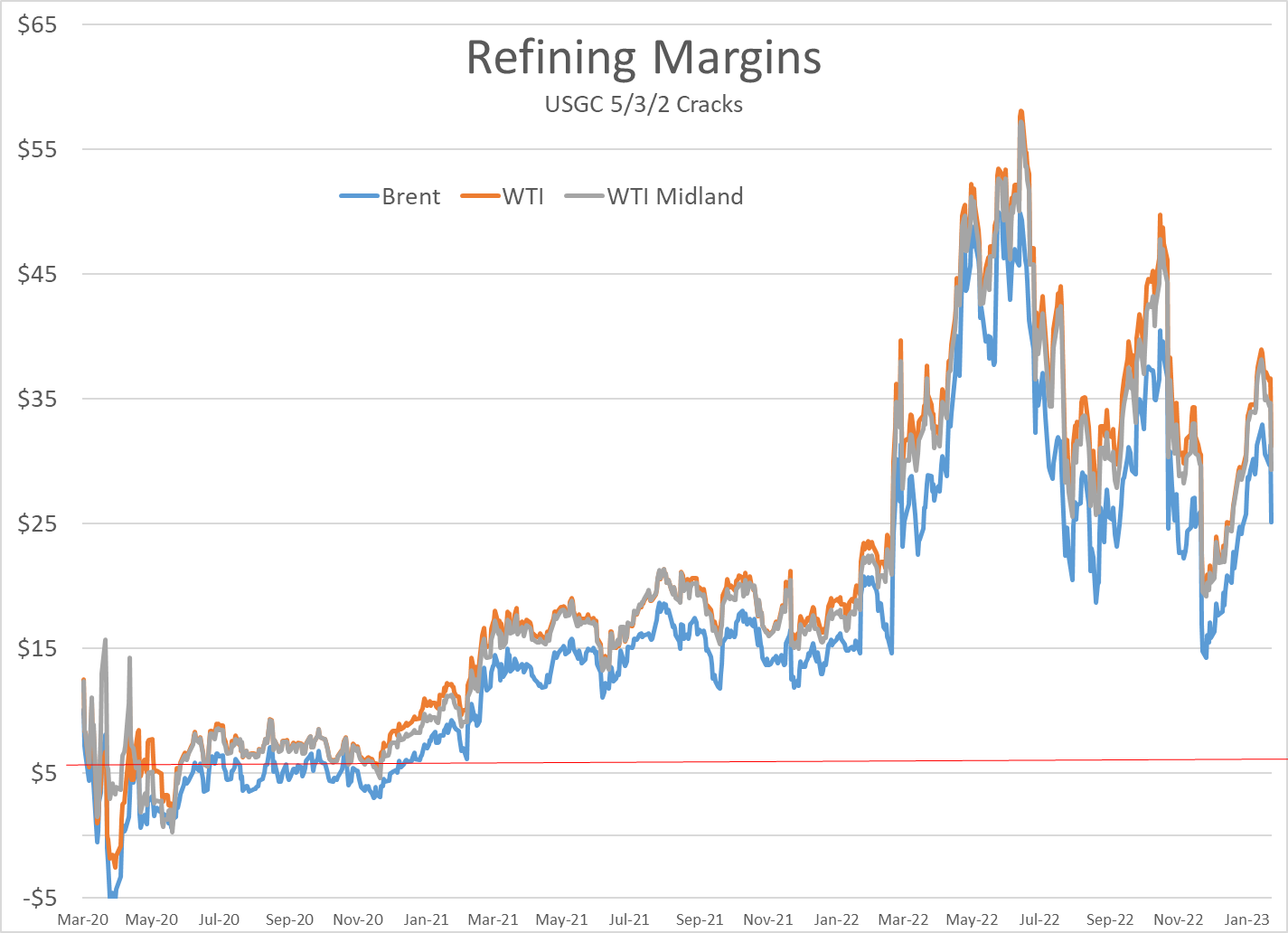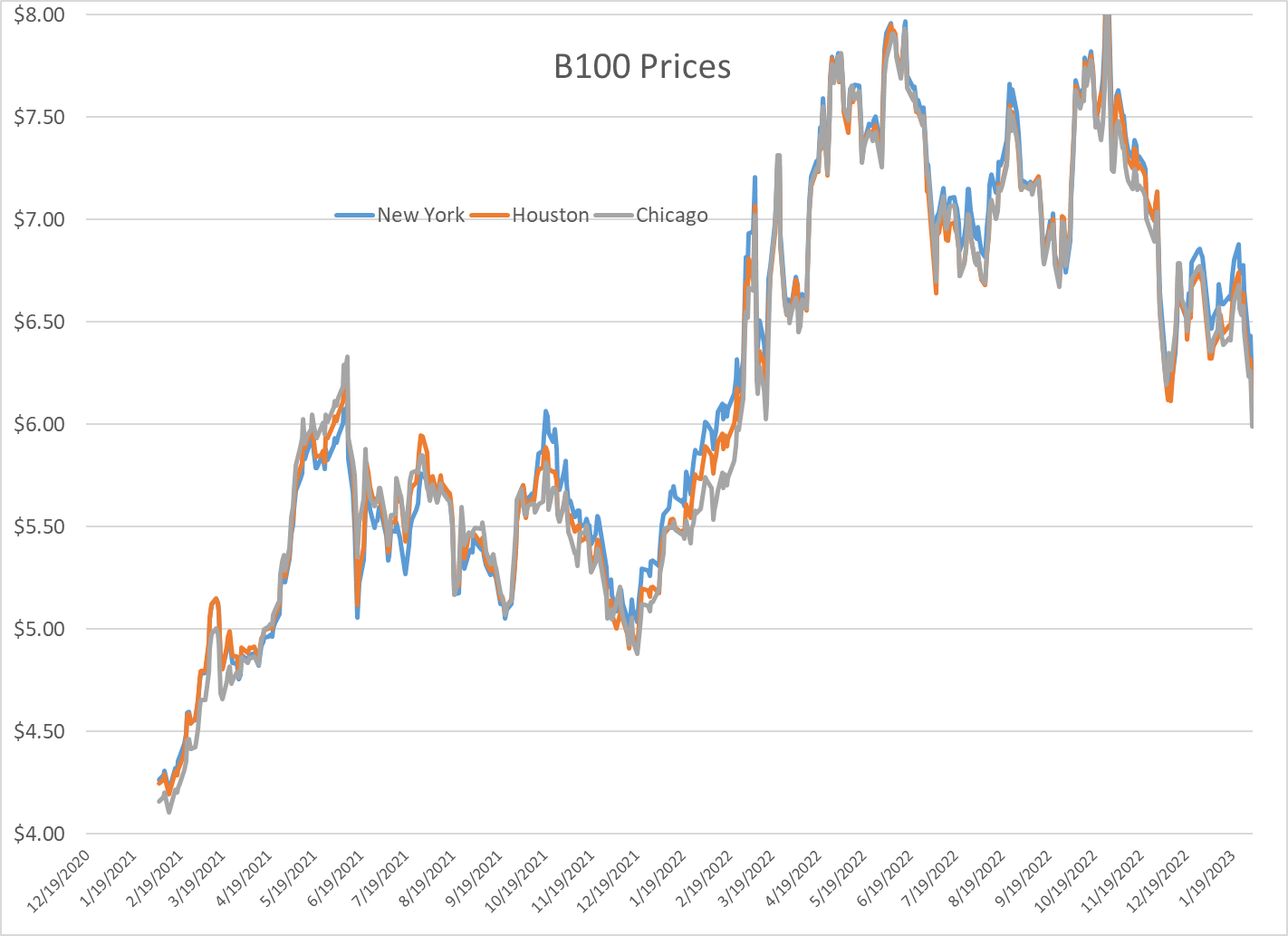Diesel Prices Collapse, Return To December Levels

Diesel prices led another big wave of selling to start February trading Wednesday and are following through with lower prices again this morning. A combination of bearish technical and fundamental factors seem to be at play with the plunging diesel prices that have wiped out half of the impressive gains in refining margins since prices bottomed out 2 months ago.
The move also came despite a big drop in the US dollar and surging equity prices after the Fed Chair’s press conference Wednesday which was apparently viewed through rose colored glasses by the easy money crowd.
It took 12 trading days for ULSD prices to rally from $2.92 to $3.58 in January, but just 6 to give all 66 cents back. Sellers wasted little time once the weekly trendlines broke Wednesday completing the cycle and pushing prices right back to the $2.92 range. This sets up a potentially pivotal test for the balance of the week, with a break and hold below the January lows setting the stage for a run at the December lows of $2.76, while a hold here could set up a period of sideways trading within the confines of the January range.
B100 prices have also dropped around 70 cents/gallon over the past week as bio blends race lower to stay competitive with the sudden drop in diesel prices. Adding to the challenge for bio-blenders that sell a $6 fuel in a $3 diesel market are RIN values that have seen their first significant selling in 2 months, lowering the subsidy for blending those fuels, while LCFS credits remain stuck in the low $60s which is less than 1/3 of where they were 2 years ago.
Speaking of government subsidies influence on bio-fuels, the largest renewable diesel producer in the US announced plans to shift direction and make its next major investment in Sustainable Aviation Fuels as the latest blenders tax credit package offers up to a 75 cent advantage for SAF blenders vs RD and Biodiesel, while all 3 fuels will be competing for the same feedstocks.
Refinery runs dipped last week as a large reduction in PADD 5 (west coast) runs offset a large increase in PADD 2 (Midwest). The PADD 5 run rate fell to a 2 year low following several unplanned events coinciding with the annual spring maintenance season as facilities tool up to produce summer grade gasoline. We had already seen San Francisco spot gasoline differentials jump nearly 40 cents/gallon over the past week, and LA spots followed suit Wednesday, jumping to a 3-month high north of 36 cents over futures.
The DOE’s weekly report showed inventories continuing to build despite the dip in refinery runs, with distillate demand the ugly number on the week. Even though diesel inventories remain uncomfortably low across most regions, days of supply are approaching average levels thanks to a very weak start to the year for diesel consumers. There’s no doubt that unseasonably warm winter weather on the East Coast (prior to this weekend anyway) has contributed to that weak demand, and the weeks of rain on the West Coast certainly didn’t help, but gauging the market’s reaction, there’s also some fear that the slump in diesel demand is an indicator of slowing economic activity.
Gasoline demand meanwhile saw a healthy increase for a 3rd straight week, but continues to hold below the 5-year average, and has only outpaced 2022 numbers 1 out of 4 weeks so far this year. Gasoline exports remain near the top end of their 5-year range, while distillate exports have been steady near the 5-year average so far this year. The severe weather that swept the gulf coast refinery zone may have limited the exports over the past two weeks however, so don’t be surprised to see a big drawdown if there’s a backlog of ships that clears in February.
More bad news for Colorado. Yesterday the Suncor refinery reported a leak, which is impressive considering it hasn’t been operating since the Christmas blizzard, which will no doubt add time and headaches to their repair process. Then overnight the P66 refinery in Borger TX, which has pipeline access to supply Colorado, was said to shut units for at least the 3rd time since being damaged by that same storm.
Latest Posts
Markets Rallying To End The Week, Diesel Prices Lead The Way For Energy
Energy Markets Rally Again Thursday After A Choppy Wednesday Session
Week 16 - US DOE Inventory Recap
Energy Markets Trading Quietly In The Red As Ethanol Prices Rally To Five-Month High
Social Media
News & Views
View All
Markets Rallying To End The Week, Diesel Prices Lead The Way For Energy
Energy markets are rallying to end the week, with diesel prices leading the way up 2.5 cents in the early going. Equity markets are also rallying after a big Thursday selloff as strong tech earnings seem to be outweighing the FED’s favorite inflation gauge remaining stubbornly high.
RBOB gasoline futures are trading higher for a 4th straight day, but despite bouncing nearly 14 cents from Tuesday’s low, they still need to rally another nickel to break the downward sloping pattern forming on the weekly charts. Seasonal factors could go either way for gasoline for the next few weeks as we’re in the Spring peaking window, and while the high set April 12th would fit the annual pattern nicely, a May price peak is certainly not unusual, and if $2.85 is broken it seems like RBOB will run to $3 in a hurry.
Diesel prices have bounced 7 cents after touching a 5-month low on Monday but need to climb back above $2.60 to reduce the chance of a slide to $2.20 or lower should the chart support around $2.50 break down.
Back to the shadow war: After a relatively quiet few weeks in the Red Sea, Houthi attacks on ships have started again over the past few days, although so far, no major damage has been reported.
ExxonMobil reported another strong quarter in Q1 with more than $10 billion in free cash flow generated, even though earnings in its refining segment were down 67% from the first quarter of last year. The company noted the success of its Beaumont refinery expansion that came online last year and marked the only major refinery expansion in the US in over a decade. It's worth noting that within the refining segment, international earnings suffered more than domestic facilities did, with non-US refining earnings down 77% from a year ago as crack spreads came back to reality after the record-setting quarters in 2022 and 2023.
Chevron followed a similar pattern (as expected) in its Q1 report, noting strong operating cash flows of $6.8 billion in total, despite downstream earnings falling more than 56% for the quarter.
The company also highlighted its expanding marketing network along the US West and Gulf Coast markets encompassing more than 250 retail stations and highlighted its new solar-to-hydrogen project in California.
Phillips 66 continued the trend, reporting a “strong” quarter in which earnings were 63% lower than a year ago. The company highlighted the conversion of its Rodeo refinery which is now producing roughly 30mb/day of RD and is expected to ramp up to 50mb/day in the 2nd quarter. That facility had a capacity of more than 120mb/day prior to its conversion, and it used to produce gasoline along with its diesel. The company also noted its ongoing plans to sell assets that no longer fit its strategy, highlighting retail assets in Germany and Austria as being on the chopping block, while not mentioning any of its US refining assets that have long been rumored to be for sale.
Delek reported another upset at its Alon Big Spring refinery Thursday, which has become another one of the TCEQ’s frequent fliers after suffering damage from the cold snaps in both 2021 and earlier this year.
A harsh reality sinking in: Mexico’s President has made plenty of headlines with fictitious claims of energy sovereignty in the past few years, but not only is the country’s new Dos Bocas refinery still not producing finished products on any sort of meaningful scale, two of its other facilities have suffered fires recently forcing the country to import even more product from the US. This phenomenon continues to help US Gulf and West coast refiners who would be struggling (even more) to move their excess with sluggish domestic demand.
Click here to download a PDF of today's TACenergy Market Talk.

Energy Markets Rally Again Thursday After A Choppy Wednesday Session
Energy markets are trying to rally again Thursday after a choppy Wednesday session. RBOB gasoline futures are leading the push higher, on pace for a 3rd consecutive day of gains after finding a temporary floor Tuesday and have added 12 cents from those lows.
Equity markets are pointing sharply lower after a weak Q1 GDP estimate which seems to have contributed to a pullback in product prices over the past few minutes, but don’t be surprised if the “bad news is good news” low interest rate junkies start jumping in later on.
The DOE’s weekly report showed sluggish demand for gasoline and diesel, but inventory levels in most markets continue to follow their typical seasonal trends. Refinery runs held fairly steady last week with crude inputs down slightly but total gross throughputs up slightly as most facilities are now back online from a busy spring maintenance season and geared up for peak demand this summer.
Propane and propylene exports spiked to a record high north of 2.3 million barrels/day last week, which demonstrates both the US’s growing influence on global product markets, and the steady shift towards “other” products besides traditional gasoline and diesel in the level of importance for refiners.
The EIA acknowledged this morning that its weak diesel consumption estimates reflected the switch to Renewable Diesel on the West Coast, although they did not provide any timeline for when that data will be included in the weekly survey. The agency acknowledged that more than 4% of the total US consumption is now a combination of RD and Biodiesel, and that number is expected to continue to grow this year. This morning’s note also suggested that weak manufacturing activity was to blame for the sluggish diesel demand across the US, while other reports suggest the freight recession continued through Q1 of this year, which is also contributing to the big shift from tight diesel markets to oversupplied in several regions.
Valero kicked off the Q1 earnings releases for refiners with solid net income of $1.2 billion that’s a far cry from the spectacular earnings north of $3 billion in the first quarter of 2023. The refining sector made $1.7 billion, down from $4.1 billion last year. That is a pattern that should be expected from other refiners as well as the industry returns to a more normal market after 2 unbelievable years. You wouldn’t guess it by looking at stock prices for refiners though, as they continue to trade near record highs despite the more modest earnings.
Another pattern we’re likely to see continue with other refiners is that Renewable earnings were down, despite a big increase in production as lower subsidies like RINs and LCFS credit values sting producers that rely on those to compete with traditional products. Valero’s SAF conversion project at its Diamond Green joint venture is progressing ahead of schedule and will give the company optionality to flip between RD and SAF depending on how the economics of those two products shakes out this year. Valero also shows part of why refiners continue to disappear in California, with operating expenses for its West Coast segment nearly 2X that of the other regions it operates in.





